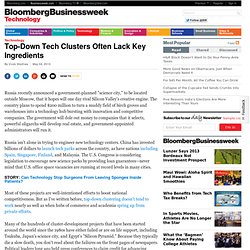

Top-Down Innovation: Leaders Define Innovative Culture. By Langdon Morris. Russian "Silicon Valley Skolkovo": Will it work? - Opinions - The Dutch Eye. Can you really rattle with a bag of gold to attrackt multi-billion dollar corporations into investing in a new Russian "Silicon Valley" initiative? Is this really the way to revitalise the poor state of Russian Science? Skolkovo Valley: Why it is needed? From a government point of view - currently Skolkovo is mainly President Medvedev's pet project - there are a number of factors and goals to be achieved by the newly - build from scratch - scientific Skolkovo City. Russia has inherited a rich scientific base from Soviet times, but it has had trouble drawing foreign investment and commercializing homegrown scientific innovations.Diversify the Russian economy by reducing its dependence on oil and gas exports and encouraging the development of hi-tech sectors and research.
Curb the brain drain from Russia which took place after the fall of Communism and continues today as conditions for scientists are very meager. The projected issues and problems for Skolkovo Valley What opponents say. Top-Down Tech Clusters Often Lack Key Ingredients. INNOVATION - INNOVATION LEADERSHIP IN PRACTICE - II - Steering innovation, top-down - By Professor Jean-Philippe Deschamps - Mastering Technology Enterprise - Driving Strategic Innovation. This Tomorrow’s Challenge is the second in a series on innovation leadership. The first part, Promoting bottom-up innovation , looked at how to build a company culture that encourages and supports bottom-up innovation – the spontaneous innovation that comes from the ideas and entrepreneurship of a company’s people.
Bottom-Up vs. Top-Down Innovation - and Hot Air. Bottom-Up vs. Top-Down Innovation - and Hot Air "Hot Air" by Marjorie Priceman is a delightful children's book about the first hot-air balloon - invented by brothers Joseph-Michel and Jacques-Étienne Montgolfier. In September, 1783 their Aerostat Réveillon reached 1,500 feet, its passengers being a sheep, a duck and a rooster. The Montgolfiers thought that smoke propelled the balloon. Years later it was discovered that hot air rises because it weighs less than cool air. More than two centuries later, the debate over the source of innovation rages on: Does change come from daring researchers (the Montgolfiers)? Health policy wonks - especially those interested in the transformative power of health information technology (HIT) - are fixated on whether innovation comes from the "bottom up" (the patient/consumer) or the "top down" (government or the hospital).
The management and health policy communities tend to ignore the reality of the happy accident. Lessons from a New Industry Cluster in India. Top-Down Innovation. CEOs have another - and an increasingly urgent - assignment to add to their leadership portfolios: driving innovation and tearing down barriers that may prevent it.

CEOs have another - and an increasingly urgent - assignment to add to their leadership portfolios: driving innovation and tearing down barriers that may prevent it. To make this happen, they may have to tell shareholders to look beyond the next quarter's results, and they'll have to broaden their own thinking. But if they don't lead innovative efforts at their own businesses, competitors will gain ground. A recent survey of 765 CEOs conducted by IBM's Business Consulting Services group found that two-thirds of the respondents expect their organizations to be inundated with change over the next two years. Most see themselves as the necessary catalyst to make it all go smoothly. And it's a tough business climate for thinking out of the box, Koulopoulos adds. Taking Down Barriers CIOs agree. Sharing Is Key More Insights. Top-Down Tech Clusters Often Lack Key Ingredients. Russia recently announced a government-planned "science city," to be located outside Moscow, that it hopes will one day rival Silicon Valley's creative engine.

The country plans to spend $200 million to turn a muddy field of birch groves and warehouses into a technology hub bursting with innovation and competitive companies. The government will dole out money to companies that it selects, powerful oligarchs will develop real estate, and government-appointed administrators will run it. Russia isn't alone in trying to engineer new technology centers.
China has invested billions of dollars to launch tech parks across the country, as have nations including Spain, Singapore, Finland, and Malaysia. The U.S. Most of these projects are well-intentioned efforts to boost national competitiveness. Slight evidence for cluster theory Academics, including Harvard Business School's Michael Porter and many management consultants, have been prescribing central-clustering development plans for decades.
Le Système national d'innovation russe en restructuration. Le processus d’innovation administré : le modèle soviétique Dans les économies socialistes fermées, notamment en Union Soviétique, le système national d’innovation avait une structure qui correspondait à la mise en œuvre et au suivi de relations contractuelles encadrées par l’État (Hanson & Pavitt, 1987 ; Radosevic, 1997, 2003) (voir aussi schéma 2) : le cadre légal était caractérisé par le plan, la propriété étatique, la hiérarchie et la bureaucratie ;au sein de l’infrastructure de recherche-développement, il existait une distinction forte entre la recherche fondamentale et la recherche appliquée : la recherche fondamentale était menée essentiellement par les académies des sciences et la recherche appliquée par les instituts de branches. Russian start-up culture and innovation.